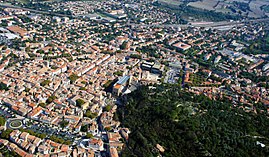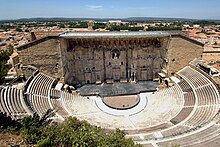
Back Orange, Vaucluse Afrikaans Aurenja AN أورانج (فوكلوز) Arabic اورانج (تجمع سكان فى كانتون اوف اورانج-ويست) ARZ Aurenja Breton Aurenja Catalan ОгӀанж CE Orange, Vaucluse CEB Orange (Francie) Czech Orange (Ffrainc) Welsh
Orange
Aurenja (Occitan) | |
|---|---|
 Aerial view of central Orange | |
| Coordinates: 44°08′18″N 4°48′35″E / 44.1383°N 4.8097°E | |
| Country | France |
| Region | Provence-Alpes-Côte d'Azur |
| Department | Vaucluse |
| Arrondissement | Carpentras |
| Canton | Orange |
| Intercommunality | Pays Réuni d'Orange |
| Government | |
| • Mayor (2021–2026) | Yann Bompard[1] (LS) |
Area 1 | 74.2 km2 (28.6 sq mi) |
| Population (2022)[2] | 29,357 |
| • Density | 400/km2 (1,000/sq mi) |
| Time zone | UTC+01:00 (CET) |
| • Summer (DST) | UTC+02:00 (CEST) |
| INSEE/Postal code | 84087 /84100 |
| Elevation | 24–127 m (79–417 ft) (avg. 50 m or 160 ft) |
| 1 French Land Register data, which excludes lakes, ponds, glaciers > 1 km2 (0.386 sq mi or 247 acres) and river estuaries. | |
| UNESCO World Heritage Site | |
|---|---|
 | |
| Includes | Roman Theatre of Orange and Triumphal Arch of Orange |
| Criteria | Cultural: iii, vi |
| Reference | 163 |
| Inscription | 1981 (5th Session) |
Orange (French pronunciation: [ɔʁɑ̃ʒ] ⓘ; Provençal: Aurenja (classical norm) or Aurenjo (Mistralian norm)) is a commune in the Vaucluse department in the Provence-Alpes-Côte d'Azur region in Southeastern France.[3] It is about 21 km (13 mi) north of Avignon, on the departmental border with Gard, which follows the Rhône and also constitutes the regional border with Occitania. Orange is the second-most populated city in Vaucluse, after Avignon.
- ^ "Répertoire national des élus: les maires". data.gouv.fr, Plateforme ouverte des données publiques françaises (in French). 2 December 2020.
- ^ "Populations de référence 2022" (in French). The National Institute of Statistics and Economic Studies. 19 December 2024.
- ^ Commune d'Orange (84087), INSEE.



